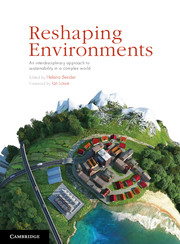Book contents
- Frontmatter
- Contents
- Contributors
- Acknowledgements
- Introduction Reshaping environments – an opportunity for envisioning the future
- Part 1 Cases
- Part 2 Skills
- Part 3 Theory
- 13 Conceptualising change
- 14 Sustainability
- 15 Human needs and norms
- 16 Conceptualising and thinking about environmental systems
- 17 Why scale matters
- Index
- Plate Section
- References
16 - Conceptualising and thinking about environmental systems
from Part 3 - Theory
Published online by Cambridge University Press: 05 February 2013
- Frontmatter
- Contents
- Contributors
- Acknowledgements
- Introduction Reshaping environments – an opportunity for envisioning the future
- Part 1 Cases
- Part 2 Skills
- Part 3 Theory
- 13 Conceptualising change
- 14 Sustainability
- 15 Human needs and norms
- 16 Conceptualising and thinking about environmental systems
- 17 Why scale matters
- Index
- Plate Section
- References
Summary
Introduction
Most of the intriguing issues to do with the environment, sustainability and development can appear to be complicated to the point of being overwhelming. The best example is climate change. It operates on a global scale with literally billions of stakeholders of which many are yet to be born and stretches our understanding of science and social interactions. To engage with an issue like this requires a framework to help think about it in a way that provides some clarity and simplicity but still approximates reality. Conceiving the issue from a systems perspective provides one such avenue to help focus on and understand aspects of the issue without losing sight of the whole picture. This chapter introduces systems and systems thinking as analysis tools that may be applied to gain an understanding of environmental systems and an approach to investigating and managing complex issues.
In the latter half of the 20th century, there was a growing interest and engagement of people worldwide in issues to do with the appropriate use of the biophysical environment. This followed a period when education to a high level was not common for the majority of people. However, people were starting to question the role of science and the expert in making decisions on their behalf. An example of the articulation of this problem was a paper by Rittel and Webber (1973) who coined the term ‘wicked problems’. A key idea of their paper was that different people would conceive the same problem in different ways. As a consequence, they would not necessarily agree on a single solution to the problem because there were multiple solutions, depending on how the problem was framed. A common type of problem of this form concerns the management, or reshaping, of the environment for human benefit.
- Type
- Chapter
- Information
- Reshaping EnvironmentsAn Interdisciplinary Approach to Sustainability in a Complex World, pp. 352 - 367Publisher: Cambridge University PressPrint publication year: 2012



